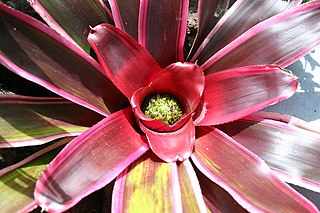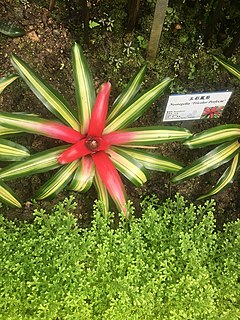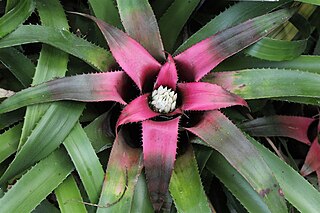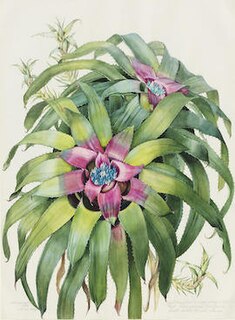
The Bromeliaceae are a family of monocot flowering plants of about 80 genera and 3700 known species, native mainly to the tropical Americas, with several species found in the American subtropics and one in tropical west Africa, Pitcairnia feliciana.

Neoregelia is a genus of epiphytic flowering plants in the family Bromeliaceae, subfamily Bromelioideae, native to South American rainforests. The genus name is for Eduard August von Regel, Director of St. Petersburg Botanic Gardens in Russia (1875–1892).

Aechmea nudicaulis is a bromeliad species in the genus Aechmea, which is often used as an ornamental plant. This species is native to Central America, the West Indies, central and southern Mexico, and northern and central South America.

Bromelioideae is a subfamily of the bromeliads (Bromeliaceae). This subfamily is the most diverse, represented by the greatest number of genera with about 40. Most of the plants in this group are epiphytes, though some have evolved in, or will adapt to, terrestrial conditions. This subfamily features the most plant types which are commonly cultivated by people, including the pineapple.

Hylaeaicum eleutheropetalum is a species of flowering plant in the family Bromeliaceae, native to tropical South America. It was first described in 1907.
Neoregelia kerryi is a species of flowering plant in the genus Neoregelia. This species is endemic to Brazil. Its name is also incorrectly spelt Neoregelia kerryae.

Aechmea mertensii is a plant species in the genus Aechmea. This species is native to Bolivia, Brazil, Colombia, Ecuador, Guyana, French Guiana, Peru, Suriname, and Venezuela.

Guzmania monostachia is an epiphytic species in the genus Guzmania. Also known as a West Indian tufted airplant, this species is native to South America, Central America, the West Indies and Florida. The species is also reportedly naturalized in Hawaii.
Racinaea spiculosa is a plant species in the genus Racinaea. This species is native to Bolivia, Brazil, Costa Rica, Venezuela and Ecuador.

Hylaeaicum is a genus of flowering plant in the family Bromeliaceae, native to tropical northern South America. The taxon was first described by Ernst Heinrich Georg Ule in 1935 as a subgenus of "Aregelia". It was later treated as a subgenus of Neoregelia, before being raised to a full genus in 2021, a status accepted by both Plants of the World Online and the Encyclopaedia of Bromeliads.
Guzmania melinonis is a species of plant in the genus Guzmania. This species is native to Bolivia, Peru, Colombia, the Guianas, Venezuela, Amazonas State of Brazil, and Ecuador.
Hylaeaicum mooreanum is a species of flowering plant in the family Bromeliaceae, native to Ecuador and northern Peru. It was first described by Lyman Bradford Smith in 1962 as Neoregelia mooreana.
Hylaeaicum levianum is a species of flowering plant in the family Bromeliaceae, native to northern Brazil, Colombia and Venezuela. It was first described by Lyman Bradford Smith in 1968 as Neoregelia leviana.
Tillandsia fragrans, synonym Vriesea fragrans, is a species of flowering plant in the family Bromeliaceae, native to north-west South America. It was first described by Édouard André in 1888.
Tillandsia heterandra, synonym Vriesea heterandra, is a species of flowering plant in the family Bromeliaceae, native to north-west South America. It was first described by Édouard André in 1888.

Hylaeaicum margaretae is a species of flowering plant in the family Bromeliaceae, endemic to Brazil. It was first described in 1968 as Neoregelia margaretae. The specific epithet pays homage to Margaret Mee, a British botanical artist who carried out fifteen expeditions to the Amazon rainforest to collect and paint rare or endangered plant species, including many species of Bromeliaceae.
Hylaeaicum meeanum is a species of flowering plant in the family Bromeliaceae, endemic to Brazil. It was first described in 1975 as Neoregelia meeana. It was first collected by Margaret Mee, near the source of Rio Andirá, near Parintins. It may be treated as a synonym of Hylaeaicum levianum, but as of November 2022 was accepted by Plants of the World Online and the Encyclopaedia of Bromeliads.
Hylaeaicum peruvianum is a species of flowering plant in the family Bromeliaceae, endemic to Peru. It was first described by Lyman Bradford Smith in 1963 as Neoregelia peruviana.
Hylaeaicum tarapotoense is a species of flowering plant in the family Bromeliaceae, endemic to northern Peru. It was first described in 1985 as Neoregelia tarapotoensis. It was first collected near Tarapoto in the Department of San Martín in northern Peru.

Hylaeaicum wurdackii is a species of flowering plant in the family Bromeliaceae, endemic to northern Peru. It was first described by Lyman Bradford Smith in 1963 as Neoregelia wurdackii.









